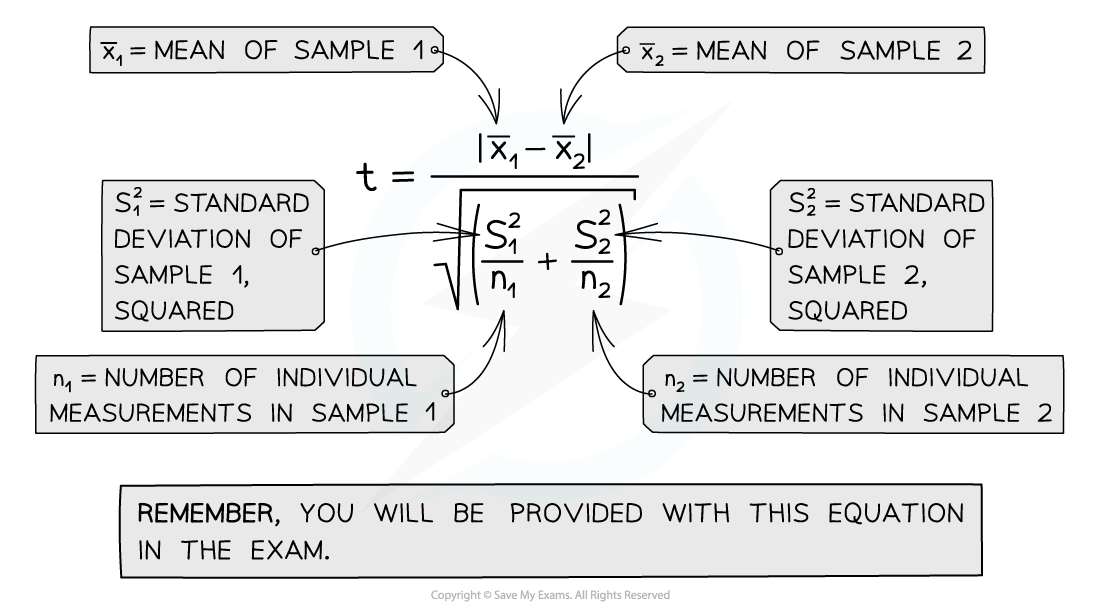Variation: t-test Worked Example (OCR A Level Biology): Revision Note
Exam code: H420
Variation: t-test worked example
The t test method can be used to determine whether the means of two data sets are significantly different
Worked Example
The ear lengths of two populations of rabbits were measured.
Ear lengths of population A (mm):
62, 60, 59, 61, 60, 58, 59, 60, 57, 56, 59, 58, 60, 59, 57
Ear lengths of population B (mm):
58, 59, 57, 59, 59, 57, 55, 60, 57, 58, 59, 58, 57, 58, 59
Use the t-test to determine whether there is a significant difference in ear length between the two populations.
Null hypothesis: There is no significant difference between the ear lengths of the rabbits in populations A and B
Sample sizes:
Population A: n1 = 15
Population B: n2 = 15
Step 1: calculate the mean for each data set:
Mean for population A x̅1 = 885 ÷ 15 = 59 mm
Mean for population B x̅2 = 870 ÷ 15 = 58 mm
Step 2: calculate the standard deviation (s) for each data set

Calculate ∑(x - x̄)2
Population A | Population B | ||
|---|---|---|---|
Difference between value and mean (x - x̄) | Difference between value and mean squared (x - x̄)2 | Difference between value and mean (x - x̄) | Difference between value and mean squared (x - x̄)2 |
62 - 59 = 3 | 9 | 58 - 58 = 0 | 0 |
60 - 59 = 1 | 1 | 59 - 58 = 1 | 1 |
59 - 59 = 0 | 0 | 57 - 58 = -1 | 1 |
61 - 59 = 2 | 4 | 59 - 58 = 1 | 1 |
60 - 59 = 1 | 1 | 59 - 58 = 1 | 1 |
58 - 59 = -1 | 1 | 57 - 58 = -1 | 1 |
59 - 59 = 0 | 0 | 55 - 58 = -3 | 9 |
60 - 59 = 1 | 1 | 60 - 58 = 2 | 4 |
57 - 59 = -2 | 4 | 57 - 58 = -1 | 1 |
56 - 59 = -3 | 9 | 58 - 58 = 0 | 0 |
59 - 59 = 0 | 0 | 59 - 58 = 1 | 1 |
58 - 59 = -1 | 1 | 58 - 58 = 0 | 0 |
60 - 59 = 1 | 1 | 57 - 58 = -1 | 1 |
59 - 59 = 0 | 0 | 58 - 58 = 0 | 0 |
57 - 59 = -2 | 4 | 59 - 58 = 1 | 1 |
Total ∑(x - x̄)2 | 36 | Total ∑(x - x̄)2 | 22 |
Calculate
Population A (n1 = 15) | Population B (n2 = 15) |
|---|---|
n1 - 1 = 14 | n2 - 1 = 14 |
∑(x - x̄)2 = 36 so 36 ÷ 14 = 2.57 | ∑(x - x̄)2 = 22 so 22 ÷ 14 = 1.57 |
Steps 3-5: use the standard deviations to complete the t test

| Population A | Population B |
|---|---|---|
Mean (x̄) | 59 | 58 |
Standard deviation (s) | 1.60 | 1.25 |
Sample size (n) | 15 | 15 |

Step 6: calculate the degrees of freedom (v) for the data:
v = (n1 - 1) + (n2 - 1)
= 14 + 14
= 28
Step 7: determine where the t value lies in relation to values in a critical values table
Degrees of freedom | Value of t | |||
|---|---|---|---|---|
28 | 1.70 | 2.05 | 2.76 | 3.67 |
Probability that chance would have produced this value of t | 0.1 | 0.05 | 0.01 | 0.001 |
The t value is 1.90, which falls between 1.70 and 2.05 in the critical values table
In biology we are looking for a less than 5 % probability that any difference between data sets is due to chance, so we are concerned with whether our t valuer is higher or lower than 2.05
Step 8: draw a conclusion
A conclusion should contain:
A reference to the t value, the critical value, the degrees of freedom and the probability level
Whether or not there is a significant difference between the means of the two data sets
Whether the null hypothesis is accepted or rejected
The t value of 1.90 is less than the critical value of 2.05 at 28 df and a probability level of 0.05
There is no significant difference between the data sets and we can accept the null hypothesis. Any difference between the mean ear lengths of population A and population B is due to chance.

Unlock more, it's free!
Did this page help you?